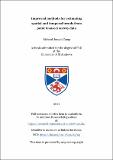Files in this item
Improved methods for estimating spatial and temporal trends from point transect survey data
Item metadata
| dc.contributor.advisor | Thomas, Len | |
| dc.contributor.author | Camp, Richard Joseph | |
| dc.coverage.spatial | xxix, 192 p. | en_US |
| dc.date.accessioned | 2021-07-09T13:33:48Z | |
| dc.date.available | 2021-07-09T13:33:48Z | |
| dc.date.issued | 2021-06-29 | |
| dc.identifier.uri | https://hdl.handle.net/10023/23506 | |
| dc.description.abstract | This thesis is about methods for improving estimates of abundance and trends from distance sampling surveys. My particular focus is on point transect surveys of endemic Hawaiian songbirds. When critical assumptions are met, design-based distance sampling provides unbiased abundance estimates; however, for rare endangered Hawaiian forest birds, the estimates can have high variance, hindering their use in assessing conservation efforts. One approach to improve precision is to use spatial models instead of design-based methods. I fitted density surface models (DSMs), accounting for spatial and temporal correlation, using a two-stage approach that separated modelling of detection probability from modelling spatio-temporal patterns in density using generalized additive models (GAMs). Precision was improved and maps depicted spatio-temporal patterns in densities. I compared the model that I fitted for a single year to two alternative approaches: spatial point-process model based on a log-Gaussian Cox process with a Matérn covariance (LGCP) and a soap-film smoother. The GAM-based DSMs and LGCP approaches produced better precision than the design-based method but varied in how they captured pattern in the data. I also implemented a GAM that used a smoother which took into account the study area boundary (a soap-film smoother) and found this produced better extrapolations into parts of the study area not surveyed. Including biological realism is another approach to improve modelling of population change over time is to link design-based abundance estimates to an underlying population dynamics model, using a state-space modelling framework. This constrains population changes to be biologically realistic, as I demonstrate with a set of models that make different assumptions about the demographic parameters driving population changes. Overall, I demonstrate that spatial, spatio-temporal and population dynamics modelling procedures reduced the variance in density estimates in single- and multi-year abundance data compared to design-based methods, thus better informing management and conservation decisions. | en_US |
| dc.description.sponsorship | "Funding to support my research and write my thesis was partially provided through a studentship from Centre for Research into Ecological & Environmental Modelling, University of St Andrews and partially provided by the U.S. Geological Survey." -- Institutional funding acknowledgements | en |
| dc.language.iso | en | en_US |
| dc.publisher | University of St Andrews | |
| dc.subject | Density estimation | en_US |
| dc.subject | Distance sampling | en_US |
| dc.subject | Point-transect sampling | en_US |
| dc.subject | Soap-film smoother | en_US |
| dc.subject | Spatio-temporal smoother | en_US |
| dc.subject | State-space modeling | en_US |
| dc.subject | Variance propagation | en_US |
| dc.subject.lcc | QA276.6C2 | |
| dc.subject.lcsh | Sampling (Statistics) | en |
| dc.subject.lcsh | Birds--Behavior--Statistical methods | en |
| dc.subject.lcsh | Forest birds--Hawaii | en |
| dc.title | Improved methods for estimating spatial and temporal trends from point transect survey data | en_US |
| dc.type | Thesis | en_US |
| dc.contributor.sponsor | University of St Andrews. Centre for Research into Ecological and Environmental Modelling (CREEM) | en_US |
| dc.contributor.sponsor | Geological Survey (U.S.) | en_US |
| dc.type.qualificationlevel | Doctoral | en_US |
| dc.type.qualificationname | PhD Doctor of Philosophy | en_US |
| dc.publisher.institution | The University of St Andrews | en_US |
| dc.rights.embargoreason | Embargo period has ended, thesis made available in accordance with University regulations | en |
| dc.identifier.doi | https://doi.org/10.17630/sta/95 |
This item appears in the following Collection(s)
Items in the St Andrews Research Repository are protected by copyright, with all rights reserved, unless otherwise indicated.

